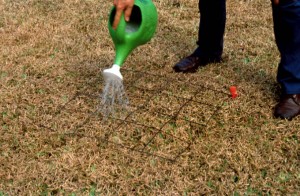Irritating liquids. Soapy water (e.g., one to two tablespoons of liquid dishwashing detergent like Dawn® per gallon of water) is irritating to insects. This liquid can be used to collect and monitor insect pest populations in turf grass by using a watering can to sprinkle about 1 gallon of soap-water solution over about 2 square feet of turf. Sod webworms, armyworms, mole crickets, and other mobile insects will crawl our of the thatch within a few minutes where they can be hand-picket or removed using tweezers. Some insecticide products containing pyrethrins have instructions to make an irritating liquid for sampling insects on the product labels.
Flotation samplers. Many insects either float naturally or will float in salty water (e.g., a saturated solution of Epson salts). This tendency can be used to collect and sample insects like chinch bugs
in turf grass. Cylindrical metal “core” samplers are inserted through the thatch into the soil and then filled with water. Within minutes insects will float to the surface where they can be removed or counted to make population level estimates over space and time. A coffee can with both lids removed makes an ideal floatation sampler.
Sieves and screen-bottom buckets. To extract insects like ant lion larvae and pupae from sand, a kitchen sieve can be used to sift out the insects. For insects that live in mud, such as rice water weevil larvae and horse and deer fly larvae buckets or wooden frames with screens on the bottom are used. Mud or plant roots can be washed free of soil in the bucket while it is immersed or using a stream of pressurized water. Larvae will either float to the surface, as do rice water weevil larvae, or can be removed from the screen after rinsing.
Grubbing. White grubs, the immature stages of May and June beetles (Scarabidae) are frequently encountered while tilling soil preparing home vegetable gardens. In turf grass areas, scientists sample for white grubs by cutting a 1-foot square into the thatch, removing the grass and sifting through the soil underneath the layer of thatch. The grass square can be replaced after sampling the soil.


